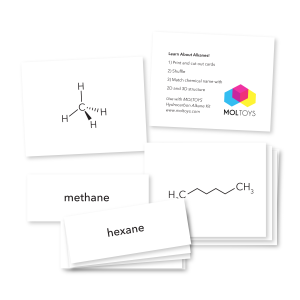Learn about Hydrocarbons!
Download the following flashcards and match the chemical name with the 2D structure. Want a challenge? Try matching the 3D structure with these hydrocarbon models.

Alkanes
Alkanes are saturated hydrocarbons, organic compounds made of entirely hydrogen and carbon, in which all the carbon-carbon bonds are single. The general chemical formula is C(n)H(2n+2), where n indicates the number of carbon atoms. For example, when n = 1 the chemical formula is CH4, which is methane.
Alkenes
Alkenes are unsaturated hydrocarbons, organic compounds made of entirely hydrogen and carbon, that contain at least one carbon-carbon double bond. The general chemical formula is C(n)H(2n), where n indicates the number of carbon atoms. For example, when n = 2 the chemical formula is C2H4, which is the simplest alkene, ethene (also known as ethylene).
Alkynes
Alkynes are unsaturated hydrocarbons, organic compounds made of entirely hydrogen and carbon, that contain at least one carbon-carbon triple bond. The general chemical formula is C(n)H(2n-2), where n indicates the number of carbon atoms. For example, when n = 2 the chemical formula is C2H2, which is the simplest alkyne, ethyne (also known as acetylene).
Alkadienes
Alkadienes are acyclic branched or unbranched hydrocarbons (organic compounds made of entirely hydrogen and carbon) having two carbon-carbon double bonds.
Cycloalkanes
Cycloalkanes are molecules composed of hydrogen and carbon atoms arranged in a single ring structure (with possible side chains), where all the carbon-carbon bonds are single. The general chemical formula is C(n)H2(n+1-r), where n indicates the number of carbon atoms and r is the number of rings. For example, when n = 4 and r = 1the chemical formula is C4H8, which is cyclobutane.
